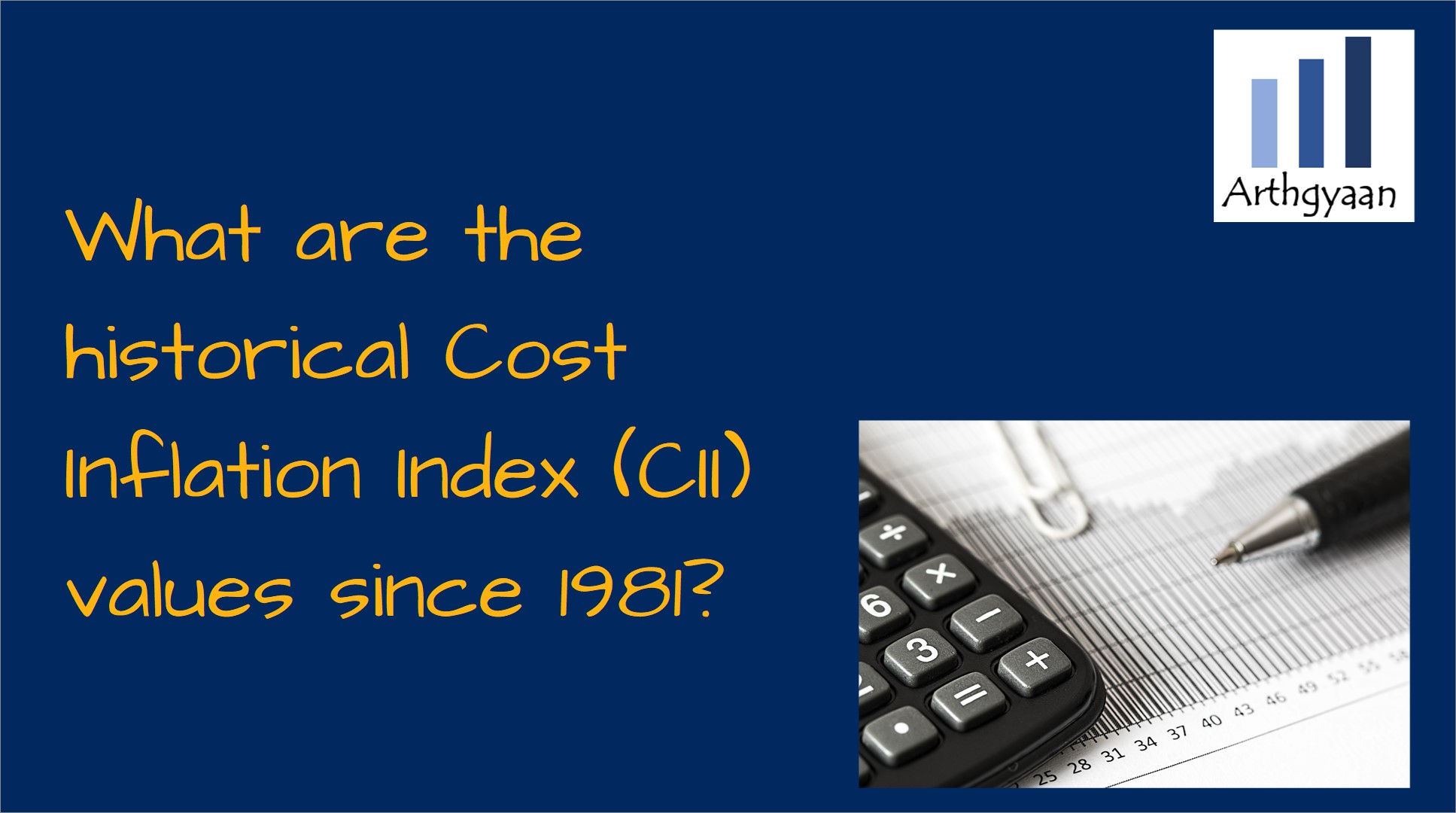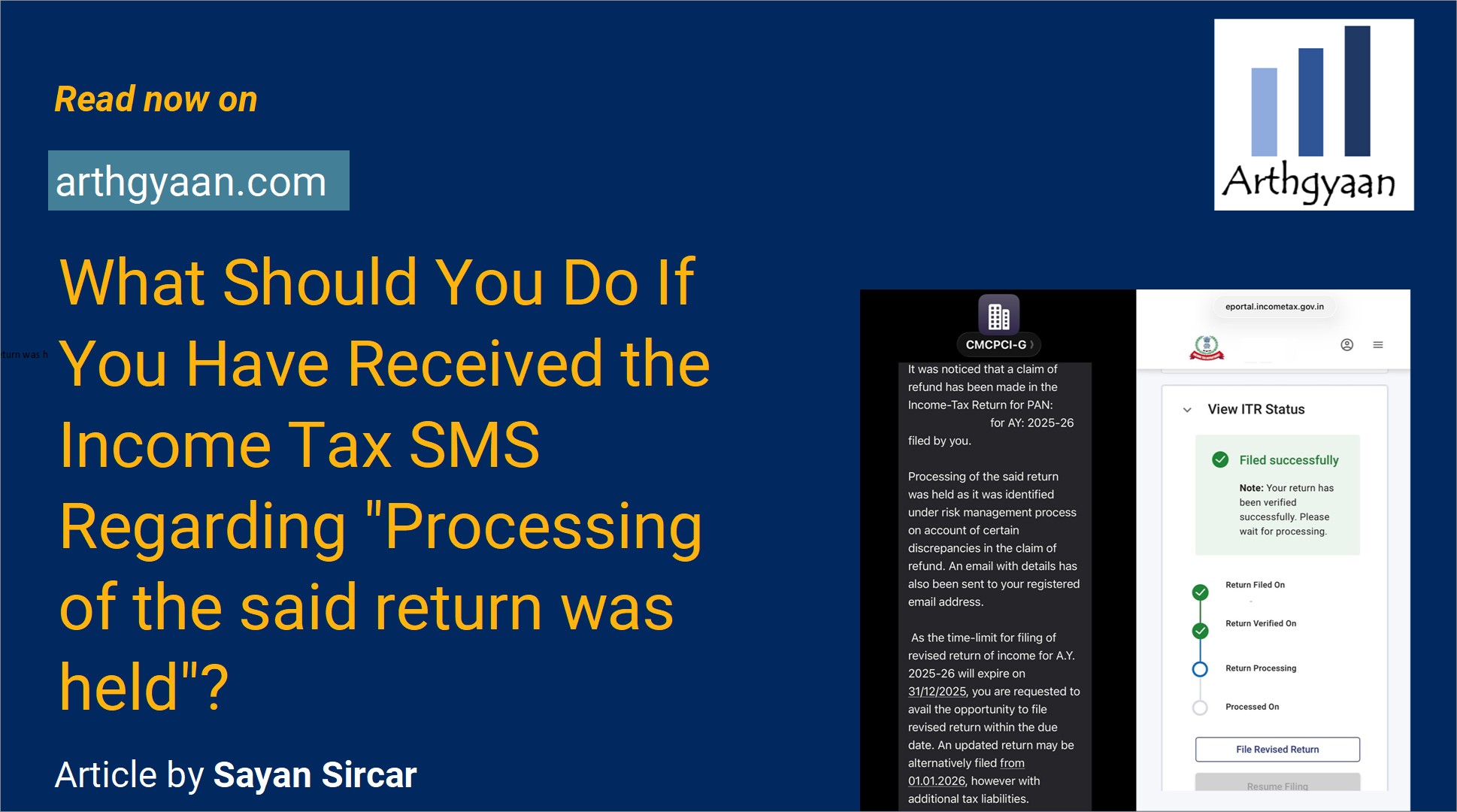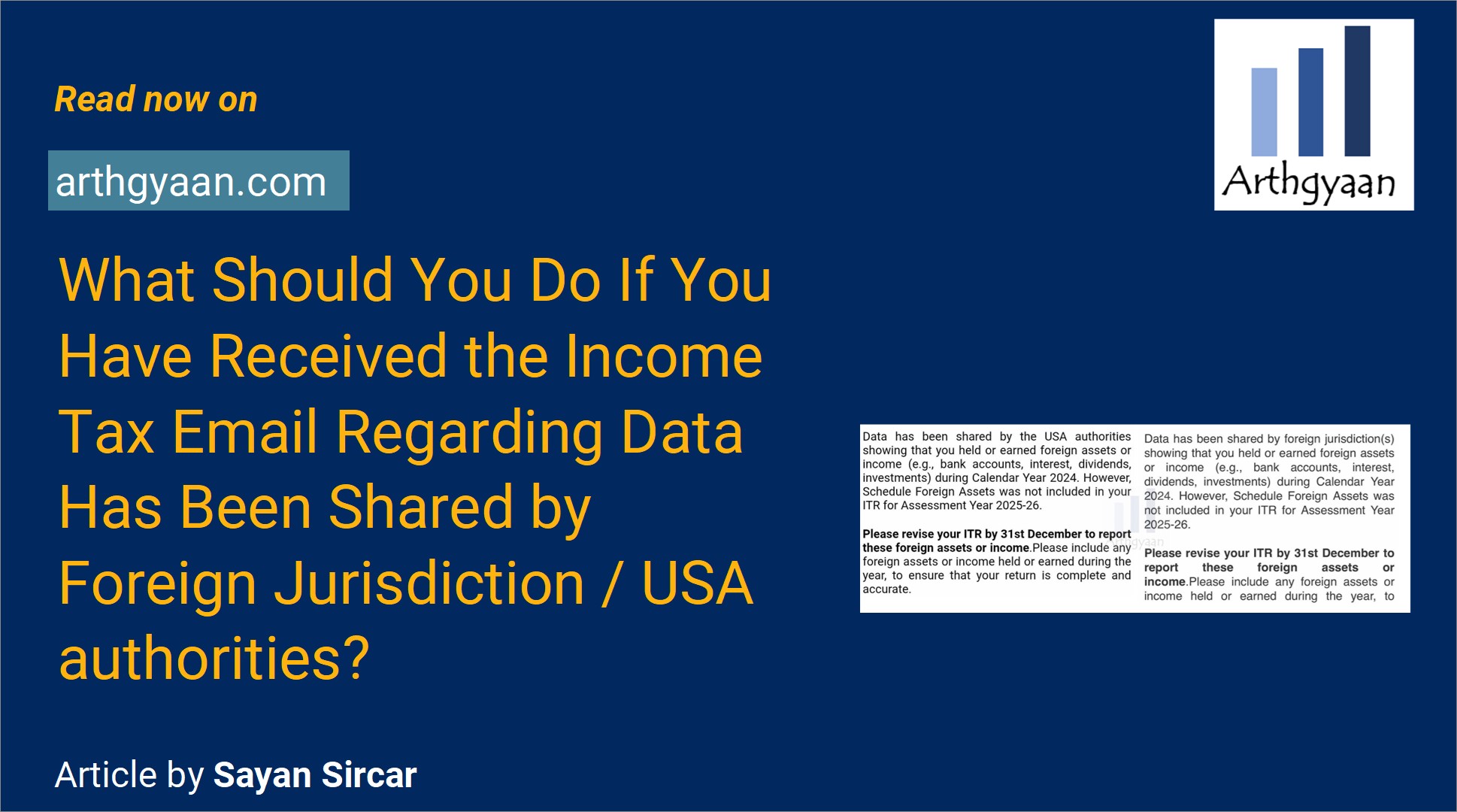What are the historical Cost Inflation Index (CII) values since 1981?
This article lists the historical Cost Inflation Index (CII) values since 1981 which are to be used for capital gains tax calculation for assets purchased before 2001.
This article lists the historical Cost Inflation Index (CII) values since 1981 which are to be used for capital gains tax calculation for assets purchased before 2001.

The Cost Inflation Index (CII) is a number published by the Central Board of Direct Taxes (CBDT) for every financial year that is used to calculate capital gains on selling a capital asset like real estate, mutual funds, stocks or bonds.
The CII figure is published at the beginning of every financial year. It is used to rebase the purchase price of a capital asset, utilising the concept of indexation. The CII figure may be taken as a proxy for inflation. To understand how CII models inflation, have a look at how the value of ₹1,000 has changed over the years as per CII changes.
The incometax website has CII data from 1981 onwards. In this article we have shown the CII values since 1981 so that you can calculate the capital gains tax for assets purchased before 2001. Please note that the formal guidance, as per income tax laws, is to use the fair market value of the asset in 2001, as per the report from an approved assessor for capital gain tax purpose.
| Serial # | Financial Year | CII | %ch | Worth of ₹1000 |
|---|---|---|---|---|
| 1 | 1981-82 | 100 | 0.00% | 1000.0 |
| 2 | 1982-83 | 109 | 9.00% | 917.4 |
| 3 | 1983-84 | 116 | 6.42% | 862.1 |
| 4 | 1984-85 | 125 | 7.76% | 800.0 |
| 5 | 1985-86 | 133 | 6.40% | 751.9 |
| 6 | 1986-87 | 140 | 5.26% | 714.3 |
| 7 | 1987-88 | 150 | 7.14% | 666.7 |
| 8 | 1988-89 | 161 | 7.33% | 621.1 |
| 9 | 1989-90 | 172 | 6.83% | 581.4 |
| 10 | 1990-91 | 182 | 5.81% | 549.5 |
| 11 | 1991-92 | 199 | 9.34% | 502.5 |
| 12 | 1992-93 | 223 | 12.06% | 448.4 |
| 13 | 1993-94 | 244 | 9.42% | 409.8 |
| 14 | 1994-95 | 259 | 6.15% | 386.1 |
| 15 | 1995-96 | 281 | 8.49% | 355.9 |
| 16 | 1996-97 | 305 | 8.54% | 327.9 |
| 17 | 1997-98 | 331 | 8.52% | 302.1 |
| 18 | 1998-99 | 351 | 6.04% | 284.9 |
| 19 | 1999-00 | 389 | 10.83% | 257.1 |
| 20 | 2000-01 | 406 | 4.37% | 246.3 |
| 21 | 2001-02 | 426 | 4.93% | 234.7 |
| 22 | 2002-03 | 447 | 4.93% | 223.7 |
| 23 | 2003-04 | 463 | 3.58% | 216.0 |
| 24 | 2004-05 | 480 | 3.67% | 208.3 |
| 25 | 2005-06 | 497 | 3.54% | 201.2 |
| 26 | 2006-07 | 519 | 4.43% | 192.7 |
| 27 | 2007-08 | 551 | 6.17% | 181.5 |
| 28 | 2008-09 | 582 | 5.63% | 171.8 |
| 29 | 2009-10 | 632 | 8.59% | 158.2 |
| 30 | 2010-11 | 711 | 12.50% | 140.6 |
| 31 | 2011-12 | 785 | 10.41% | 127.4 |
| 32 | 2012-13 | 852 | 8.54% | 117.4 |
| 33 | 2013-14 | 939 | 10.21% | 106.5 |
| 34 | 2014-15 | 1024 | 9.05% | 97.7 |
| 35 | 2015-16 | 1081 | 5.57% | 92.5 |
| 36 | 2016-17 | 1125 | 4.07% | 88.9 |
Source: https://incometaxindia.gov.in/Documents/Cost-Inflation-Index-upto-FY-2016-17.htm
This data is now superseded by a new series from 2001 onwards: How to use the Cost Inflation Index (CII): latest value and historical rates.
We have taken the CII data table from both 1981 and 2001 and continued the 1981 series using the same percentage changes in the new series from 2017 onwards. The merged table looks like this:
| Serial # | Financial Year | CII | %ch | Worth of ₹1000 |
|---|---|---|---|---|
| 1 | 1981-82 | 100 | 0.00% | 1000.0 |
| 2 | 1982-83 | 109 | 9.00% | 917.4 |
| 3 | 1983-84 | 116 | 6.42% | 862.1 |
| 4 | 1984-85 | 125 | 7.76% | 800.0 |
| 5 | 1985-86 | 133 | 6.40% | 751.9 |
| 6 | 1986-87 | 140 | 5.26% | 714.3 |
| 7 | 1987-88 | 150 | 7.14% | 666.7 |
| 8 | 1988-89 | 161 | 7.33% | 621.1 |
| 9 | 1989-90 | 172 | 6.83% | 581.4 |
| 10 | 1990-91 | 182 | 5.81% | 549.5 |
| 11 | 1991-92 | 199 | 9.34% | 502.5 |
| 12 | 1992-93 | 223 | 12.06% | 448.4 |
| 13 | 1993-94 | 244 | 9.42% | 409.8 |
| 14 | 1994-95 | 259 | 6.15% | 386.1 |
| 15 | 1995-96 | 281 | 8.49% | 355.9 |
| 16 | 1996-97 | 305 | 8.54% | 327.9 |
| 17 | 1997-98 | 331 | 8.52% | 302.1 |
| 18 | 1998-99 | 351 | 6.04% | 284.9 |
| 19 | 1999-00 | 389 | 10.83% | 257.1 |
| 20 | 2000-01 | 406 | 4.37% | 246.3 |
| 21 | 2001-02 | 426 | 4.93% | 234.7 |
| 22 | 2002-03 | 447 | 4.93% | 223.7 |
| 23 | 2003-04 | 463 | 3.58% | 216.0 |
| 24 | 2004-05 | 480 | 3.67% | 208.3 |
| 25 | 2005-06 | 497 | 3.54% | 201.2 |
| 26 | 2006-07 | 519 | 4.43% | 192.7 |
| 27 | 2007-08 | 551 | 6.17% | 181.5 |
| 28 | 2008-09 | 582 | 5.63% | 171.8 |
| 29 | 2009-10 | 632 | 8.59% | 158.2 |
| 30 | 2010-11 | 711 | 12.50% | 140.6 |
| 31 | 2011-12 | 785 | 10.41% | 127.4 |
| 32 | 2012-13 | 852 | 8.54% | 117.4 |
| 33 | 2013-14 | 939 | 10.21% | 106.5 |
| 34 | 2014-15 | 1024 | 9.05% | 97.7 |
| 35 | 2015-16 | 1081 | 5.57% | 92.5 |
| 36 | 2016-17 | 1125 | 4.07% | 88.9 |
| 37 | 2017-18 | 1159 | 3.03% | 86.3 |
| 38 | 2018-19 | 1193 | 2.94% | 83.8 |
| 39 | 2019-20 | 1232 | 3.21% | 81.2 |
| 40 | 2020-21 | 1283 | 4.15% | 78.0 |
| 41 | 2021-22 | 1351 | 5.32% | 74.0 |
| 42 | 2022-23 | 1411 | 4.42% | 70.9 |
| 43 | 2023-24 | 1483 | 5.14% | 67.4 |
| 44 | 2024-25 | 1547 | 4.31% | 64.6 |
| 45 | 2025-26 | 1602 | 3.58% | 62.4 |
The value of something that cost ₹1000 in FY 1981-82 would be around ₹ 16020 today.
Since the index started in FY 1981-82, we can think that the value of the Rupee has steadily decreased as per the change in the CII index. If the value of something was ₹100 when CII was 200, then that item should cost around ₹150 when CII rises to 300 (150 = 100 * 300/200). This is of course an approximation. The actual increase would depend on the product and the time period considered.
This result shows the impact of inflation very prominently. If the same trends continue for the next 40 years, then a ₹1 lakh/month lifestyle will jump to ₹16 lakhs per month. Our retirement corpus has to fund that lifestyle: Low-stress retirement planning calculations: worked out example.
The Cost Inflation Index (CII) before FY 1981-82 (AY 1982-83) is 100 as per old series.
The Cost Inflation Index (CII) for FY 1981-82 (AY 1982-83) is 100 as per old series.
The Cost Inflation Index (CII) for FY 1982-83 (AY 1983-84) is 109 as per old series.
The Cost Inflation Index (CII) for FY 1983-84 (AY 1984-85) is 116 as per old series.
The Cost Inflation Index (CII) for FY 1984-85 (AY 1985-86) is 125 as per old series.
The Cost Inflation Index (CII) for FY 1985-86 (AY 1986-87) is 133 as per old series.
The Cost Inflation Index (CII) for FY 1986-87 (AY 1987-88) is 140 as per old series.
The Cost Inflation Index (CII) for FY 1987-88 (AY 1988-89) is 150 as per old series.
The Cost Inflation Index (CII) for FY 1988-89 (AY 1989-90) is 161 as per old series.
The Cost Inflation Index (CII) for FY 1989-90 (AY 1990-91) is 172 as per old series.
The Cost Inflation Index (CII) for FY 1990-91 (AY 1991-92) is 182 as per old series.
The Cost Inflation Index (CII) for FY 1991-92 (AY 1992-93) is 199 as per old series.
The Cost Inflation Index (CII) for FY 1992-93 (AY 1993-94) is 223 as per old series.
The Cost Inflation Index (CII) for FY 1993-94 (AY 1994-95) is 244 as per old series.
The Cost Inflation Index (CII) for FY 1994-95 (AY 1995-96) is 259 as per old series.
The Cost Inflation Index (CII) for FY 1995-96 (AY 1996-97) is 281 as per old series.
The Cost Inflation Index (CII) for FY 1996-97 (AY 1997-98 ) is 305 as per old series.
The Cost Inflation Index (CII) for FY 1997-98 (AY 1998-99 ) is 331 as per old series.
The Cost Inflation Index (CII) for FY 1998-99 (AY 1999-00) is 351 as per old series.
The Cost Inflation Index (CII) for FY 1999-00 (AY 2000-01) is 389 as per old series.
The Cost Inflation Index (CII) for FY 2000-01 (AY 2001-02) is 406 as per old series.
The Cost Inflation Index (CII) for FY 2001-02 (AY 2002-03) is 426 as per old series and 100 as per new series.
The Cost Inflation Index (CII) for FY 2002-03 (AY 2003-04) is 447 as per old series and 105 as per new series.
The Cost Inflation Index (CII) for FY 2003-04 (AY 2004-05) is 463 as per old series and 109 as per new series.
The Cost Inflation Index (CII) for FY 2004-05 (AY 2005-06) is 480 as per old series and 113 as per new series.
The Cost Inflation Index (CII) for FY 2005-06 (AY 2006-07) is 497 as per old series and 117 as per new series.
The Cost Inflation Index (CII) for FY 2006-07 (AY 2007-08) is 519 as per old series and 122 as per new series.
The Cost Inflation Index (CII) for FY 2007-08 (AY 2008-09) is 551 as per old series and 129 as per new series.
The Cost Inflation Index (CII) for FY 2008-09 (AY 2009-10) is 582 as per old series and 137 as per new series.
The Cost Inflation Index (CII) for FY 2009-10 (AY 2010-11) is 632 as per old series and 148 as per new series.
The Cost Inflation Index (CII) for FY 2010-11 (AY 2011-12) is 711 as per old series and 167 as per new series.
The Cost Inflation Index (CII) for FY 2011-12 (AY 2012-13) is 785 as per old series and 184 as per new series.
The Cost Inflation Index (CII) for FY 2012-13 (AY 2013-14) is 852 as per old series and 200 as per new series.
The Cost Inflation Index (CII) for FY 2013-14 (AY 2014-15) is 939 as per old series and 220 as per new series.
The Cost Inflation Index (CII) for FY 2014-15 (AY 2015-16) is 1024 as per old series and 240 as per new series.
The Cost Inflation Index (CII) for FY 2015-16 (AY 2016-17) is 1081 as per old series and 254 as per new series.
The Cost Inflation Index (CII) for FY 2016-17 (AY 2017-18) is 1125 as per old series and 264 as per new series.

Published: 23 December 2025
6 MIN READ

Published: 18 December 2025
8 MIN READ
1. Email me with any questions.
2. Use our goal-based investing template to prepare a financial plan for yourself.Don't forget to share this article on WhatsApp or Twitter or post this to Facebook.
Discuss this post with us via Facebook or get regular bite-sized updates on Twitter.
More posts...Disclaimer: Content on this site is for educational purpose only and is not financial advice. Nothing on this site should be construed as an offer or recommendation to buy/sell any financial product or service. Please consult a registered investment advisor before making any investments.
This post titled What are the historical Cost Inflation Index (CII) values since 1981? first appeared on 21 Nov 2023 at https://arthgyaan.com
Copyright © 2021-2025 Arthgyaan.com. All rights reserved.